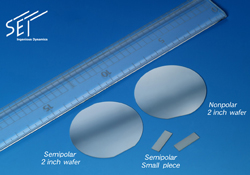- News
24 November 2010
SEI announces first 2” semipolar/nonpolar GaN for green lasers
Japan’s Sumitomo Electric Industries Ltd (SEI) says that it has developed production technology enabling large-scale production of 2-inch diameter semipolar/nonpolar gallium nitride (GaN) substrates for green semiconductor lasers.
 For white light-emitting diodes (LEDs) and blue-violet or blue semiconductor laser diodes, the c-plane crystal face of a GaN substrate is generally used. However, with positively charged gallium (Ga) and negatively charged (N) atoms oriented alternately, the c-plane exhibits strong polarization, which decreases light-emitting efficiency in the green region.
For white light-emitting diodes (LEDs) and blue-violet or blue semiconductor laser diodes, the c-plane crystal face of a GaN substrate is generally used. However, with positively charged gallium (Ga) and negatively charged (N) atoms oriented alternately, the c-plane exhibits strong polarization, which decreases light-emitting efficiency in the green region.
Following its development of green semiconductor lasers in 2009, Sumitomo Electric has been developing manufacturing technology for semipolar and nonpolar GaN substrates (rather than polar c-plane GaN), which can improve the performance of green lasers and white LEDs. These efforts have resulted in the development of manufacturing technologies that inhibit piezoelectric effects on polarized substrates, improving device luminous efficiency.
In general, semipolar and nonpolar GaN substrates are manufactured by vertically or diagonally slicing GaN crystals along the crystallographic c-plane. However, this method results in relatively small crystals (rectangular crystals with dimensions on the order of several millimeters). The size of these materials has been a major obstacle to increasing the production scale of higher-efficiency LED devices, says the firm.
To overcome this limitation, Sumitomo Electric has hence developed HVPE (hydride vapor phase epitaxy) manufacturing technology for large-scale production of 2-inch substrates. The firm says that the substrates produced using this technique exhibit a dislocation density on the order of 105, which is comparable to that of the c-plane substrates currently in use.
SEI’s {20-21} semi-polar green laser lowers threshold current by 2–3x
SEI unveils first 6” GaN substrates for white LEDs
SEI Green lasers GaN substrates
